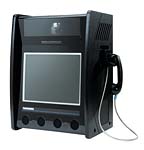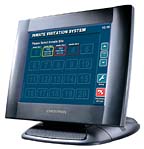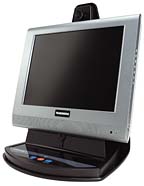Courthouse Aftermath: Video Conference an Answer

Most counties are addressing the security issue through technology, and the type that appears to be implemented the most is video conferencing. Already in use by legal systems throughout the world, video conferencing is revolutionizing the way cases are tried in America today. By simply installing one video conferencing system at the courthouse and another at the jail, incarcerated defendants can participate in all legal procedures without the municipality enduring the costs and dangers associated with jail-to-courthouse prisoner transport.
The monetary savings to a county become clear when one considers that costly resources need to be allocated, such as: several policemen, a vehicle, courthouse security, gasoline and tolls, among others. Depending on several factors, among them the distance of the courthouse to the jail and geographic location, these costs can sometimes reach into the thousands of dollars, even for just one trip. Over the course of a year, the result is a hefty bill that video conferencing aims to eliminate.

Study of advantages
In October 2003, at the request of the Badger State Sheriff’s Association, which represents sheriff departments in various Wisconsin counties, the Wisconsin Office of Justice Assistance initiated a study into the possible time- and cost-saving benefits of video conferencing. The study revealed a savings of about $2.7 million if all counties used the technology. That data, along with the obvious security benefits, was enough for the state’s Green County to move full speed ahead with video conferencing.
Like many courthouses, Green County’s proposed video conferencing system had been in the planning stages for quite some time; the incident in Atlanta proved to be the spark needed to move the project forward. “Video conferencing is the wave of future,” said James Beer, the Green County Circuit Court Judge told reporters. “It shows the court is moving into the 21st century.” The equipment will enable doctors to appear at mental health proceedings and people who are serving time in prison to appear remotely. “The benefits are limitless. It saves the county a great deal of money and also increases security here at the courthouse,” said Beer.

“Because it has such technology, Abington and other large departments serve as a central booking center for defendants,” said Montgomery Deputy Chief John Livingood in media coverage. “Video arraignments are time savers because defendants never have to leave the police station to see the judge. If we had to take a person to see the judge in person, it would effectively take two officers out of service for at least a couple of hours.” Livingood also noted the length of time could be longer if the on-call judge were located across the county.

Openness as well as security
In Montgomery County, police and deputy sheriffs, rarely constables, shuttle defendants to the county prison, said District Judge Paul Leo, whose court in Hatboro, Pa., has used video conferencing for about two years. While the technology enables a judge to do work from home, that’s not how it’s being used in his courtroom, he said, noting how the courts should remain open to the public, regardless if the proceeding is captured on a computer screen.
Video conferencing equipment manufacturers, for their part, have responded to the demand by introducing a series of products aimed at this sector. And while manufactures are providing the product, solution providers are providing education and support. From courthouses to jails, and prisons to law firms, solution providers, who have been preaching the many benefits of video conferencing, are finally being heard, perhaps simply because these days, the technology is becoming easier to justify.
Risk and cost
One example of that risk-to-cost consideration comes from deliberations right now at the Davidson County Courthouse in Forsyth County, N.C.
There is a debate between those who favor the use of private security officers for entry screening and those who want sheriff’s deputies to handle screening as well as in-court security. Using deputies at entrances could cost the operation more than $100,000. But implementation of electronic security inside the facility – including video conferencing – could shift some deputies to the entrances.
On another courtroom front, the Judicial Conference, which sets policy for federal judges and courtrooms, in mid-March passed a resolution portraying a “crisis” in judicial security. The federal action, triggered by the recent murder of the husband and mother of a Chicago-based U.S. District Judge, is looking at both increased courthouse protection as well as more and better security when federal judges are at home or on the road.
Sidebar: Let’s Conference
There is increasing interest by courthouse security executives and judges in video conferencing.Tandberg (www.tandberg.net), a manufacturer of video conferencing products, recently introduced the Justice Package. It’s an integrated video solution designed specifically for the courtroom environment. As a component of the Justice Package, the Judicator conferencing system allows for simple video and audio control directly from the judge’s bench. The Judicator enables: arraignments, remote visitations, parole and mental-health hearings, depositions, medical appointments, sensitive witness and expert testimonies, attorney consultations, among others.
While manufactures are providing the product, solution providers such as IVCi (www.ivci.com) provide education and support.
Information on government, law enforcement and courthouse security is available at the click of a mouse through the Security magazine Web site at www.securitymagazine.com. At the opening Web page, use keywords and the BNP Media LINX service – powered by Google – to search and find just the right piece of information or product source.
Looking for a reprint of this article?
From high-res PDFs to custom plaques, order your copy today!







